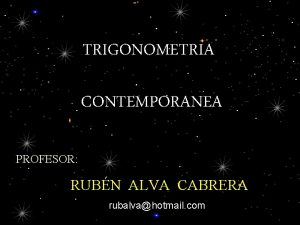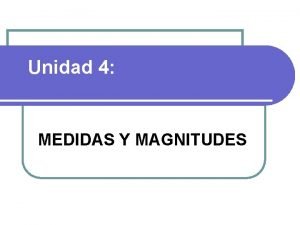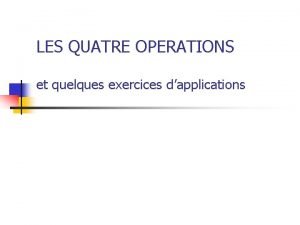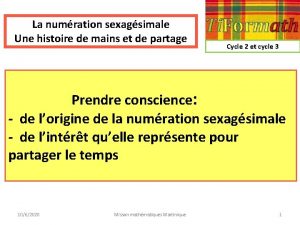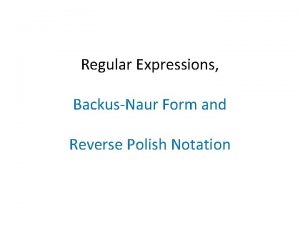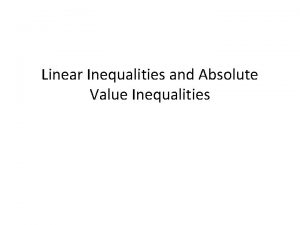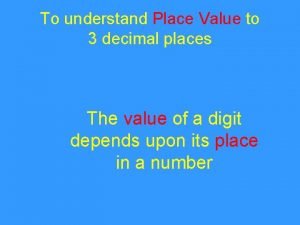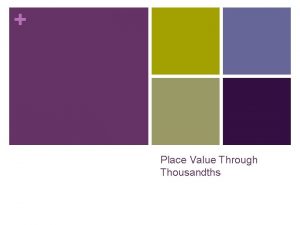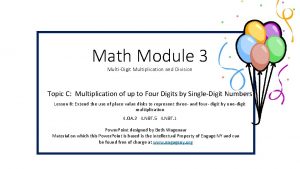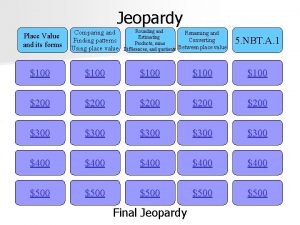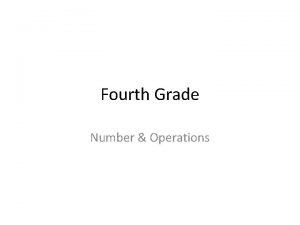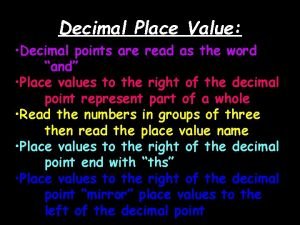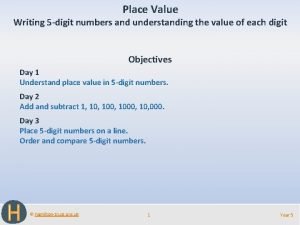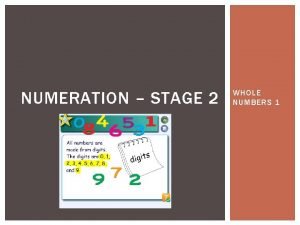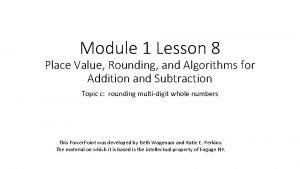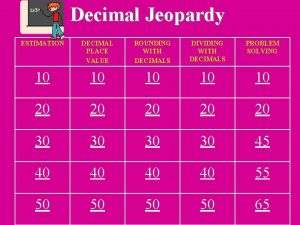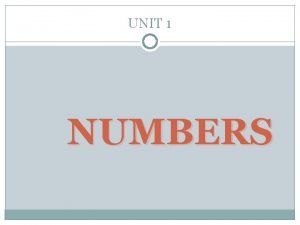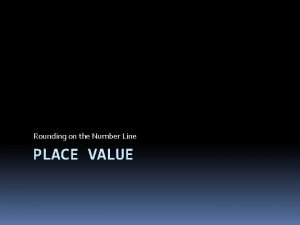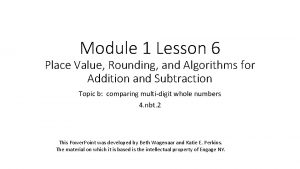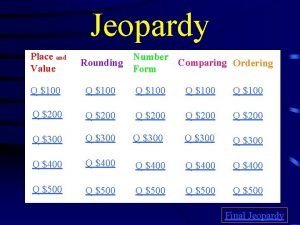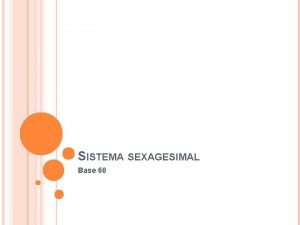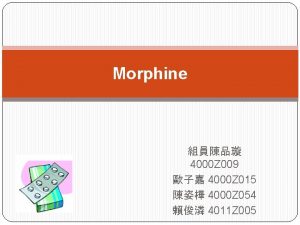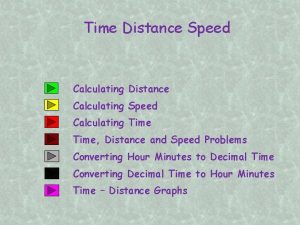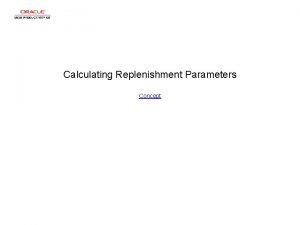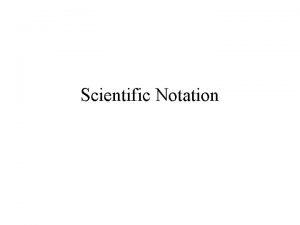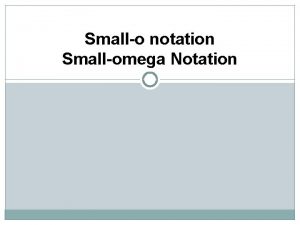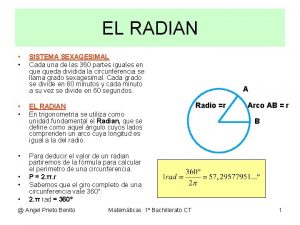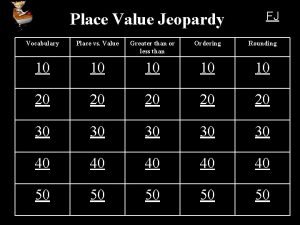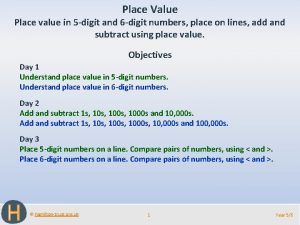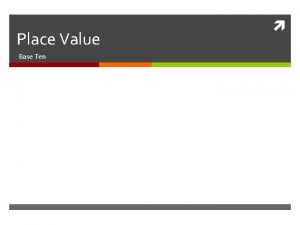Calculating in floating sexagesimal place value notation 4000


















![Reciprocal 17: 46: 40 Its reciprocal 3: 22: 30 ========== 17: 46: 40 [9] Reciprocal 17: 46: 40 Its reciprocal 3: 22: 30 ========== 17: 46: 40 [9]](https://slidetodoc.com/presentation_image/3323e7953364039cace5eb9c326576f0/image-19.jpg)


























- Slides: 45

Calculating in floating sexagesimal place value notation, 4000 years ago Christine Proust Laboratoire SPHère (CNRS & Université Paris-Diderot) ARITH 22 22 nd Symposium on Computer Arithmetic Lyon June 22 -24, 2015


François Thureau-Dangin (1872 -1944) 1938 Textes Mathématiques Babyloniens. Otto Neugebauer (1899 -1990) 1935 -1937 Mathematische Keilschrifttexte I Neugebauer & Sachs, 1945 Mathematical Cuneiform Texts.

School tablet from Nippur , Old Babylonian period (HS 217 a, University of Jena)

HS 217 a Multiplication table by 9 20 x 9 = 180 = In base 60 : But the scribes wrote: 3 x 60 3: 0 3 This is puzzling. 20 x 9 is written 3 20 x 9 = 3 The square of 30 is written 15 30 x 30 = 15 The square root of 15 is written 30

(Sachs 1947) Is the lack of graphical systems to determine the place of the unit in the number an imperfection of the cuneiform script?

yes The algorithm for reciprocals according to Abraham Sachs (1947)

no

Scribal schools in Old Babylonian period (ca. 2000 -1600 BCE) Scribal school in Nippur

The curriculum at Nippur Level Elementary Intermediate Content Metrological lists: capacities, weights, surfaces, lengths Metrological tables: capacities, weights, surfaces, lengths, heights Numerical tables: reciprocals, multiplications, squares Tables of square roots and cube roots Exercises: multiplications, reciprocals, surface and volume calculations

A list of proverbs School tablet from Nippur , Old Babylonian period (Ist Ni 5376, Istanbul) Translation: after ETCSL 6. 1. 02, 2. 48 - 1. Someone who cannot produce "a-a”, from where will he achieve fluent speech? 2. A scribe who does not know Sumerian -- from where will he produce a translation? 3. The scribe skilled in counting is deficient in writing. The scribe skilled in writing is deficient in counting. 4. A chattering scribe. Its guilt is great. 5. A junior scribe is too concerned with feeding his hunger; he does not pay attention to the scribal art. 6. A disgraced scribe becomes a priest. …

Metrological lists capacity weight School tablet from Nippur, Old Babylonian period (HS 249, University of Jena) surface length

Metrological lists: measurements of capacity School tablet from Nippur, Old Babylonian period (HS 1703, University of Jena) 1/3 sila 1/2 sila 2/3 sila 5/6 sila 1 1/3 sila 1 1/2 sila 1 2/3 sila 1 5/6 sila 2 sila 3 sila 4 sila 5 sila 6 sila 7 sila 8 sila 9 sila 1 ban še 1 ban 1 sila 1 ban 2 sila 1 ban 3 sila 3 1 sila ca. 1 liter 1 ban ca. 10 liters

1 šusi 2 šusi 3 šusi 4 šusi 5 šusi 6 šusi 7 šusi 8 šusi 9 šusi 1/3 kuš 1/2 kuš 2/3 kuš 5/6 kuš 1 1/3 kuš 1 1/2 kuš 1 2/3 kuš 2 kuš School tablet from Nippur, Old Babylonian period (HS 241, University of Jena) 10 20 30 40 50 1 1: 10 1: 20 1: 30 1: 40 2: 30 3: 20 4: 10 5 6: 40 7: 30 8: 20 10 1 šusi = 1 finger, ca. 1. 6 cm 1 kuš = 1 cubit, ca. 50 cm

Reciprocals Multiplication tables by 50 45 44: 26: 40 7: 30 40 7: 12 36 7 30 6: 40 25 6 24 5 22: 30 4: 30 20 4 18 3: 45 16: 40 3: 20 16 3 15 2: 30 12: 30 2: 24 12 2 10 1: 40 9 1: 30 8: 20 1: 20 8 1: 15 Table of squares School tablet from Nippur, Old Babylonian period (Ist Ni 2733, Istanbul Museum) Numerical tables

Table of reciprocals School tablet from unknown provenance, Old Babylonian period (MS 3874, Schøyen collection, copy Friberg) 2 3 4 5 6 8 9 10 12 15 16 18 20 24 25 27 30 32 36 40 45 30 20 15 12 10 7: 30 6: 40 6 5 4 3: 45 3: 20 3 2: 30 2: 24 2: 13: 20 2 1: 52: 30 1: 40 1: 30 1: 20 48 50 54 1 1: 4 1: 21 1: 15 1: 12 1: 6: 40 1 56: 15 44: 26: 40

The division by a number was performed by mean of the multiplication by the reciprocal of this number. 5 ÷ 30 = 5 × 2 = 10 2 ÷ 44: 26: 40 = 2 × 1: 21 = 2: 42 2 3 4 5 6 8 9 10 12 15 16 18 20 24 25 27 30 32 36 40 45 48 50 54 1 1: 4 1: 21 30 20 15 12 10 7: 30 6: 40 6 5 4 3: 45 3: 20 3 2: 30 2: 24 2: 13: 20 2 1: 52: 30 1: 40 1: 30 1: 20 1: 15 1: 12 1: 6: 40 1 56: 15 44: 26: 40

Multiplying 4 50 -----------41 40 3 20 16 -----------23 21 40
![Reciprocal 17 46 40 Its reciprocal 3 22 30 17 46 40 9 Reciprocal 17: 46: 40 Its reciprocal 3: 22: 30 ========== 17: 46: 40 [9]](https://slidetodoc.com/presentation_image/3323e7953364039cace5eb9c326576f0/image-19.jpg)
Reciprocal 17: 46: 40 Its reciprocal 3: 22: 30 ========== 17: 46: 40 [9] 2: 40 22: [30] 3: 22: [30] A chattering scribe, his guilt is great. -----------------A chattering scribe, his guilt is great =========== 17: 46: 40 9 1: 30*

Calculation of surface SPVN Metrological notations Ni 18 School tablet from Nippur Istanbul Museum

Multiplication table (SPVN) Table of surfaces SPVN → surface measure Table of lengths length measures → SPVN

School tablets from Nippur Extract of metrological table for lengths 6 šu-si 7 šu-si 8 šu-si 9 šu-si 1/ kuš 3 3 1/ kuš 1 šu-si 3 3 1/ kuš 2 šu-si 3 3 1/ kuš 3 šu-si 3 3 1/ kuš 4 šu-si 3 3 1 1. 10 1. 20 1. 30 1. 40 1. 50 2 2. 10 2. 20 SPVN Metrological notations Extract of metrological table for surfaces 1/ 1/ 2/ 5/ 3 sar 2 sar 3 sar 6 sar 1 1/3 sar 1 1/2 sar 1 2/3 sar 1 5/6 sar 20 30 40 50 1 1. 20 1. 30 1. 40 1. 50 Extract of table of squares 2 3 4 5 6 7 8 9 10 11 12 times times times 2 3 4 5 6 7 8 9 10 11 12 SPVN Metrological notations SPVN 4 9 16 25 36 49 1. 4 1. 21 1. 40 2. 1 2. 24

The algorithm for reciprocal Obverse 4: 26: 40 Its reciprocal 13: 30 ======= reverse 4: 26: 40 9 40* 1: 30 13: 30 *error of the scribe: he wrote 41 instead of 40

2 3 4 5 6 8 9 10 12 15 16 18 20 24 25 27 30 32 36 40 45 48 50 54 1 1: 4 1: 21 30 20 15 12 10 7: 30 6: 40 6 5 4 3: 45 3: 20 3 2: 30 2: 24 2: 13: 20 2 1: 52: 30 1: 40 1: 30 1: 20 1: 15 1: 12 1: 6: 40 1 56: 15 44: 26: 40 9 40 1: 30 13: 30 4: 26: 40 ends with the regular number 6: 40, so 4: 26: 40 is "divisible" by 6: 40. To divide 4: 26: 40 by 6: 40, we must multiply 4: 26: 40 by the reciprocal of 6: 40. The reciprocal of 6: 40 is 9. The number 9 is placed in the right hand column. 4: 26: 40 multiplied by 9 is 40, thus, 40 is the quotient of 4: 26: 40 by 6: 40. This quotient is placed in the left hand column. The reciprocal of 40 is 1: 30. The number 1: 30 is placed in the right hand olumn. To find the reciprocal of 4: 26: 40, one only has to multiply the reciprocals of the factors of 4: 26: 40, that is to say, the numbers 9 and 1: 30 placed in the right hand column. This product is 13: 30, the reciprocal sought.

2 3 4 5 6 8 9 10 12 15 16 18 20 24 25 27 30 32 36 40 45 48 50 54 1 1: 4 1: 21 30 20 15 12 10 7: 30 6: 40 6 5 4 3: 45 3: 20 3 2: 30 2: 24 2: 13: 20 2 1: 52: 30 1: 40 1: 30 1: 20 1: 15 1: 12 1: 6: 40 1 56: 15 44: 26: 40 9 40 1: 30 13: 30 Left hand column: 4: 26: 40 = 6: 40 × 40 Right hand column 9 × 1: 30 = 13: 30

École et érudition

Obverse: 3 columns, # 1 -16 Reverse: 3 columns, #16 -21 CBS 1215 Provenance: unknown Datation: OB period (ca. 1800 BCE) University of Pennsylvania, Philadelphia Publication: Sachs 1947, Babylonian Mathematical Texts 1 Copy Robson 2000: 14 Entries 2. 5 4. 10 8. 20 16. 40 33. 20 1. 6. 40 2. 13. 20 4. 26. 40 … 10. 6. 48. 53. 20

CBS 1215: transliteration Obverse (columns from left to right) Reverse (columns from right to left)

CBS 1215 #1 2 3 4 5 6 8 9 10 12 15 16 18 20 24 25 27 30 32 36 40 45 48 50 54 1 1: 4 1: 21 30 20 15 12 10 7: 30 6: 40 6 5 4 3: 45 3: 20 3 2: 30 2: 24 2: 13: 20 2 1: 52: 30 1: 40 1: 30 1: 20 1: 15 1: 12 1: 6: 40 1 56: 15 44: 26: 40 The factorization of 2: 5 appears in the left column: 2: 5 × 5 = 25 The factorization of the reciprocal of 2: 5 appears in the right hand column: 12 × 2: 24 = 28: 48 The reciprocal of 2: 5 is thus 28: 48. 4. 26. 40 40 13. 30 27 9 1. 30 2 2. 13. 20 4. 26. 40

CBS 1215 #8 2 3 4 5 6 8 9 10 12 15 16 18 20 24 25 27 30 32 36 40 45 48 50 54 1 1: 4 1: 21 30 20 15 12 10 7: 30 6: 40 6 5 4 3: 45 3: 20 3 2: 30 2: 24 2: 13: 20 2 1: 52: 30 1: 40 1: 30 1: 20 1: 15 1: 12 1: 6: 40 1 56: 15 44: 26: 40 4. 26. 40 40 13. 30 27 9 1. 30 2 2. 13. 20 4. 26. 40

2 3 4 5 6 8 9 10 12 15 16 18 20 24 25 27 30 32 36 40 45 48 50 54 1 1: 4 1: 21 30 20 15 12 10 7: 30 6: 40 6 5 4 3: 45 3: 20 3 2: 30 2: 24 2: 13: 20 2 1: 52: 30 1: 40 1: 30 1: 20 1: 15 1: 12 1: 6: 40 1 56: 15 44: 26: 40 CBS 1215 #20: iteration Direct sequence Left hand column: 5: 3: 24: 26: 40 = 6: 40 × 16 Right hand column: 9 × 1: 30 × 3: 45 = 11: 54: 50: 37: 30

2 3 4 5 6 8 9 10 12 15 16 18 20 24 25 27 30 32 36 40 45 48 50 54 1 1: 4 1: 21 30 20 15 12 10 7: 30 6: 40 6 5 4 3: 45 3: 20 3 2: 30 2: 24 2: 13: 20 2 1: 52: 30 1: 40 1: 30 1: 20 1: 15 1: 12 1: 6: 40 1 56: 15 44: 26: 40 Transcription 5: 3: 24: 26: 40 [9] 45: 30: 40 1: 30 1: 8: 16 3: 45 4: 16 3: 45 14: 3: 45 5[2: 44]: 3: 45 1: 19: 6: 5: 37: 30 11: 54: 50: 37: 30 2 23: 49: 41: 15 4 1: 34: 55: 18: 45 16 25: 18: 45 16 6: 45 1: 20 9 6: [40] 8: 53: 20 2: 2: 2: 13: 20 37: 55: 33: 20 2: 31: 42: 13: 20 5: 3: 24: 26: 40 Explanation: n → 5: 3: 24: 26: 40 Factors of n factors of inv(n) 6: 40 9 40 1: 30 16 3: 45 Products 14: 3: 45 5[2: 44]: 3: 45 1: 19: 6: 5: 37: 30 11: 54: 50: 37: 30 n→ 11: 54: 50: 37: 30 30 2 15 4 3: 45 16 45 1: 20 9 6: [40] Products 8: 53: 20 2: 22: 13: 20 37: 55: 33: 20 2: 31: 42: 13: 20 5: 3: 24: 26: 40 Direct sequence Left hand column: 5: 3: 24: 26: 40 = 6: 40 × 16 Right hand column: 9 × 1: 30 × 3: 45 = 11: 54: 50: 37: 30

Aspects of CBS 1215: Paradigmatic examples: Calculation performed on common values (2. 5 and doubles) that provide the ability to control the outputs, known in advance. The execution of the algorithm is guided by a codified layout: the layout of the numbers indicates the nature of the operation carried out and the meaning of the calculations. The implementation of the reverse algorithm illustrates the property "the reciprocal of a number is this number itself. "

L’algorithme d’inversion selon l’interprétation d’Abraham Sachs (1947) Abstract numbers are not quantities, but calculation tools

Plimpton 322 Columbia University, New York Old Babylonian period Provenience unknown (probably Southern Mesopotamia) 59, 30 1, 24, 30 1 Sexagesimal number = number with finite sexagesimal development Sexagesimal rectangle = length, width and diagonal are represented by sexagesimals numbers Diagonal rule = Pythagorean rule

The square (takiltum) of the diagonal (from) which 1 is torn out (i. e. subtracted) and (that of) the width comes up. width d 2 b diagonal Line n° d² - 1 = b² d d b 1 l d b l

I’ II’ The square of the diagonal (from) which 1 is torn out (i. e. subtracted) and (that of) the width comes up. 1, 59, 0, 15 − 1 = 59, 0, 15 IV’ width diagonal line 1, 59 2, 49 n° 1 1, 59 2, 49 1, 24, 30² 1² 59, 30² 1 + 59, 0, 15 = 1, 59, 0, 15 59, 30 III’ 1² 59, 30² 1, 24, 30 1 Unit rectangle Reduced rectangle

Width d = ½(r/s + s/r) b = ½(r/s - s/r) We have: d 2 - b² = 1 1<r/s < (<2; 25) r is a regular number s is a 1 -place regular number r/s is irreducible b List of all the values of r/s (John Britton according to Price 1964)

Reconstruction of complete tablet, by John Britton

A 2 3 4 5 6 8 9 10 12 15 16 18 20 24 25 27 30 32 36 40 45 48 1: 4 1: 12 1: 15 1: 20 1: 21 1: 30 1: 36 1: 40 1: 48 2: 5 B 2 3 4 5 6 8 9 10 12 15 16 18 20 24 25 27 30 32 36 40 45 48 50 50 54 1

A = 1 -place value regular numbers + 2 -place value regular numbers until 2: 5 B = 1 -place value regular numbers C = {a/b, a є A and b є B} = {{1}, {2}, {3}, {4}, {5}, {6}, {8}, {9}, {10}, {12}, {15}, {16}, {18}, {20}, {2 4}, {25}, {27}, {30}, {32}, {36}, {40}, {45}, {48}, {50}, {54}, {1, 12}, {1, 15}, {1, 20}, {1, 21}, {1, 30}, {1, 36}, {1, 40}, {1, 48}, {2, 5}, {2, 8}, {2, 15}, {2, 24}, {2, 30}, {2, 42}, {3, 12}, {3, 20}, {3, 36}, {3, 45}, {4, 3}, {4, 10}, {4, 16}, {4, 30}, {4, 48}, {5, 20}, {5, 24}, {6, 15}, {6, 24}, {6, 40}, {6, 45}, {7, 12}, {7, 30}, {8, 6}, {8, 20}, {9, 36}, {10, 25}, {1 0, 40}, {10, 48}, {11, 15}, {12, 30}, {12, 48}, {13, 20}, {13, 30}, {14, 2 4}, {16, 12}, {16, 40}, {18, 45}, {19, 12}, {20, 15}, {20, 50}, {21, 20}, { 21, 36}, {22, 30}, {26, 40}, {28, 48}, {31, 15}, {32, 24}, {33, 20}, {33, 45}, {37, 30}, {38, 24}, {40, 30}, {41, 40}, {42, 40}, {43, 12}, {53, 20}, {56, 15}, {57, 36}, {1, 2, 30}, {1, 4, 48}, {1, 6, 40}, {1, 7, 30}, {1, 16, 48 }, {1, 23, 20}, {1, 25, 20}, {1, 26, 24}, {1, 33, 45}, {1, 37, 12}, {1, 41, 15 }, {1, 46, 40}, {1, 52, 30}, {1, 55, 12}, {2, 1, 30}, {2, 9, 36}, {2, 13, 20}, { 2, 33, 36}, {2, 36, 15}, {2, 46, 40}, {2, 48, 45}, {2, 52, 48}, {3, 7, 30}, {3, 14, 24}, {3, 22, 30}, {3, 28, 20}, {3, 33, 20}, {3, 50, 24}, {4, 19, 12}, {4, 26, 40}, {4, 41, 15}, {5, 3, 45}, {5, 12, 30}, {5, 33, 20}, {5, 37, 30}, {5, 4 5, 36}, {6, 56, 40}, {7, 40, 48}, {7, 48, 45}, {8, 26, 15}, {8, 38, 24}, {8, 53, 20}, {9, 22, 30}, {10, 7, 30}, {11, 6, 40}, {11, 31, 12}, {12, 57, 36}, {13, 53, 20}, {14, 3, 45}, {15, 21, 36}, {15, 37, 30}, {16, 52, 3 0}, {17, 16, 48}, {17, 46, 40}, {22, 13, 20}, {23, 2, 24}, {23, 26, 15}, {2 5, 18, 45}, {25, 55, 12}, {27, 46, 40}, {28, 7, 30}, {30, 43, 12}, {35, 33, 20}, {38, 52, 48}, {42, 11, 15}, {44, 26, 40}, {46, 52, 30}, {50, 37, 30}, {55, 33, 20}, {1, 11, 6, 40}, {1, 15, 56, 15}, {1, 24, 22, 30}, {1, 28, 53, 2 0}, {1, 51, 6, 40}, {1, 57, 11, 15}, {2, 18, 53, 20}, {2, 22, 13, 20}, {2, 31, 52, 30}, {2, 57, 46, 40}, {3, 42, 13, 20}, {3, 54, 22, 30}, {4, 37, 46, 40}, {5, 55, 33, 20}, {7, 24, 26, 40}, {11, 51, 6, 40}, {14, 48, 53, 20}, {18, 3 1, 6, 40}, {23, 42, 13, 20}, {29, 37, 46, 40}, {37, 2, 13, 20}, {47, 24, 26, 40}, {1, 32, 35, 33, 20}} Select numbers of C between 1 and 1+ √ 2 (<2, 25), in the lexicographic order. This list is the same as the Price’s one. This list generates the first 15 entries of Plimpton 322, as well as the 23 additional entries reconstructed by Price, Britton, and others. These entries are obtained from the values n of C as follows: the diagonal is half the sum of n and its reciprocal: Column I’ contain the squares of these diagonals.

MS 3971 #3 (Friberg 2007, 252 -3) 3 1 - In order for you to see five diagonals: 2 1, 4 (is) the igi, and the igibi 56. 15 3 […] 5 -8 3 b 1 The 2 nd (example). 1, 40 the igi, 36 the igibi. 2 1, 40 and 36 heap, 2, 16 it gives. 3 ½ of 2, 16 break, 1, 8 it gives. 4 1, 8 square, 1, 17, 4 it gives. 5 1 from 1, 17, 4 tear off, 6 17, 4 it gives. 17, 4 makes 32 equalsided. 7 32, the width, it gives. 3 c The 3 rd. 1, 30 the igi, 40 the igibi. 1 1, 30 and 40 heap, 2, 10 it gives. 2 ½ of 2, 10 break, 1, 5 it gives. 3 1, 5 square, 1, 10, 25. 4 1 from 1, 10, 25 tear off, 10, 25 it gives. 10, 25 makes <25 equalsided>. 25, the 3 rd 5 width. 3 d 1 The 4 th. 1, 20 the igi, 45 the igibi. 1, 30 and 45 2 heap, 2, 5 it gives. ½ of 2, 5 break, 1, 2, 30 it 3 gives. 4 1, 2, 30 square, 1, 5, 6, 15. 5 1 from the length tear off, 5, 6, 15 it gives. 6 5, 6, 15 makes 17, 30 equalsided. 17, 30, the width of the 4 th diagonal. 3 e The 5 th. 1, 12 the igi, 50 the igibi. 1 1, 12 and 50 heap, 2, 2 it gives. ½ of 2, 2 2 break, 1, 1. 3 1, 1 square, 1, 2, 1.

3 b 1 2 3 4 5 6 7 u 1 2 1 1 1 40 36 16 8 17 17 32 The 2 nd (example). 1, 40 the igi, 36 the igibi. 1, 40 and 36 heap, 2, 16 it gives. ½ of 2, 16 break, 1, 8 it gives. 1, 8 square, 1, 17, 4 it gives. 1 from 1, 17, 4 tear off, 17, 4 it gives. 17, 4 makes 32 equalsided. 32, the width, it gives. 36 4 4 1, 40 1 Configuration of gnomon Configuration of diagonal rule

3 1 -2 In order for you to see five diagonals: 3 1, 4 (is) the igi, and the igibi 56. 15 5 -8 […] 3 b 1 2 3 4 5 6 7 3 c 1 The 3 rd. 1, 30 the igi, 40 the igibi. 2 1, 30 and 40 heap, 2, 10 it gives. 3 ½ of 2, 10 break, 1, 5 it gives. 4 1, 5 square, 1, 10, 25. 1 from 1, 10, 25 tear off, 10, 25 it gives. 5 10, 25 makes <25 equalsided>. 25, the 3 rd width. 3 d 1 2 3 4 5 6 3 e 1 2 3 4 5 Plimpton 322 The 2 nd (example). 1, 40 the igi, 36 the igibi. 1, 40 and 36 heap, 2, 16 it gives. ½ of 2, 16 break, 1, 8 it gives. 1, 8 square, 1, 17, 4 it gives. 1 from 1, 17, 4 tear off, 17, 4 it gives. 17, 4 makes 32 equalsided. 32, the width, it gives. The 4 th. 1, 20 the igi, 45 the igibi. 1, 30 and 45 heap, 2, 5 it gives. ½ of 2, 5 br eak, 1, 2, 30 it gives. 1, 2, 30 square, 1, 5, 6, 15. 1 from the length tear off, 5, 6, 15 it gives. 5, 6, 15 makes 17, 30 equalsided. 17, 30, the width of the 4 th diagonal. The 5 th. 1, 12 the igi, 50 the igibi. 1, 12 and 50 heap, 2, 2 it gives. ½ of 2, 2 break, 1, 1 square, 1, 2, 1. 1 from 1, 2, 1 tear off, 2, 1 it gives. 2, 1 makes 11 equalsided. 11, the 5 th width. 5 diagonals.

 Place place value and period
Place place value and period Sexagesimal formula
Sexagesimal formula Systeme sexagesimal
Systeme sexagesimal Mapa conceptual sobre las medidas angulares
Mapa conceptual sobre las medidas angulares Systeme sexagesimal
Systeme sexagesimal Systeme sexagesimal
Systeme sexagesimal Value creation value delivery value capture
Value creation value delivery value capture Tera prefix value
Tera prefix value Postfix to infix conversion
Postfix to infix conversion Rpn expression
Rpn expression Reversed polish notation expression
Reversed polish notation expression Waves are repeating disturbances that transfer
Waves are repeating disturbances that transfer A disturbance that transfers energy from place to place
A disturbance that transfers energy from place to place Linear and absolute value inequalities
Linear and absolute value inequalities Place value of 865
Place value of 865 3 decimal places
3 decimal places Grammar and mechanics rules for staar 2021
Grammar and mechanics rules for staar 2021 Place value symbols
Place value symbols Place value map
Place value map Base 2 place value
Base 2 place value Place value through thousandths
Place value through thousandths Place value story
Place value story Write the place value of the underlined digit
Write the place value of the underlined digit Place value drawing
Place value drawing Place value jeopardy
Place value jeopardy What is the highest mark you can get on a foundation paper
What is the highest mark you can get on a foundation paper Indian place value system
Indian place value system Place value periods
Place value periods Place value of decimals
Place value of decimals Place value year 4
Place value year 4 Place value of 5 digit numbers
Place value of 5 digit numbers Whole numbers chart
Whole numbers chart Rounding money chapter 1 lesson 8
Rounding money chapter 1 lesson 8 Place value chart eureka math
Place value chart eureka math Place value of decimals
Place value of decimals Decimal place value jeopardy
Decimal place value jeopardy Add the place value of 3 in 235 to 150
Add the place value of 3 in 235 to 150 Place value detectives
Place value detectives Place value of 46
Place value of 46 Place value of 246
Place value of 246 Place value park
Place value park Round off place value
Round off place value Millionths place
Millionths place Place value choice board
Place value choice board Lesson 6 understand decimal place value answer key
Lesson 6 understand decimal place value answer key Rounding jeopardy
Rounding jeopardy

